Warning: pic heavy, as usual. 
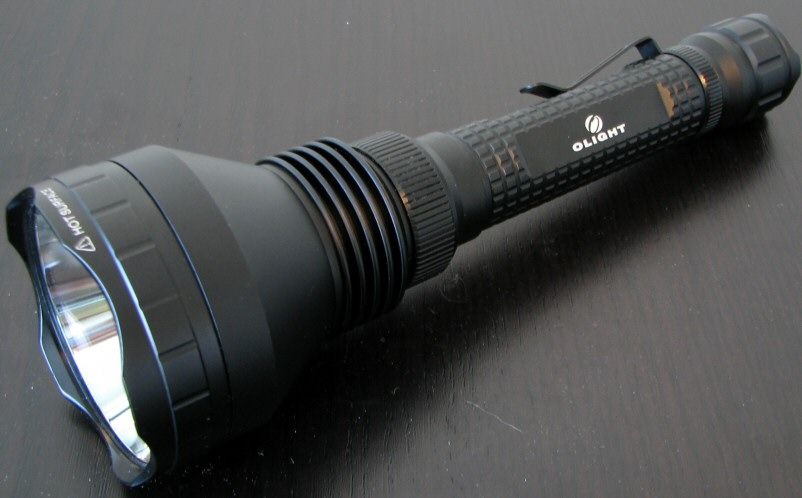
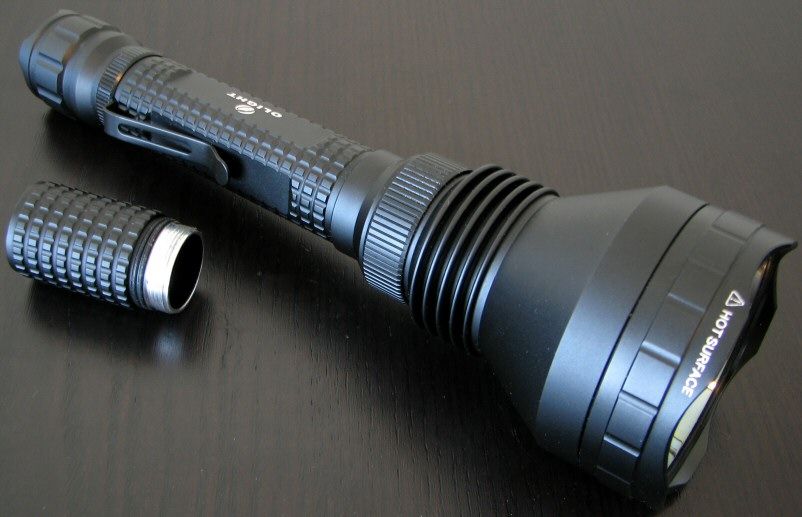
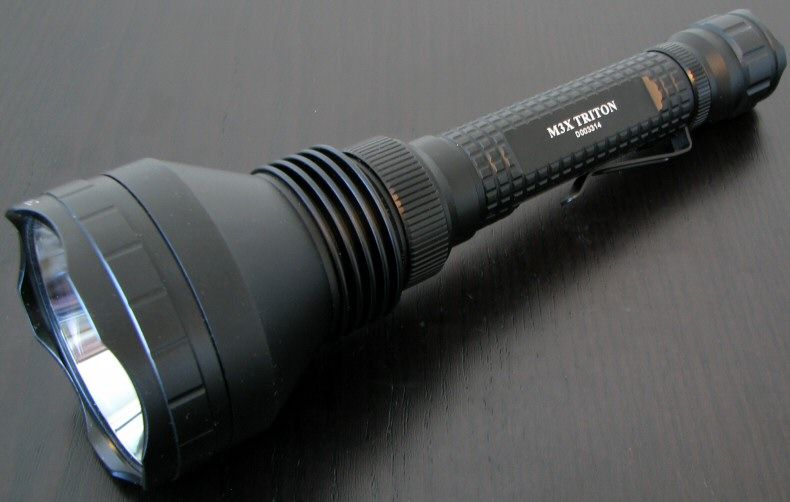
It was a little over two years ago that I review the first model in the M3x-series of lights from Olight – the SST-50-based M31. This was quickly replaced with by the XM-L-based M3X, which now sports the new XM-L2 emitter (to be reviewed here).
Physically not much has changed, but let's put the new XM-L2 version through its paces and see how it compares to some other modern "throw" lights in my collection.
Manufacturer Reported Specifications:
(note: as always, these are simply what the manufacturer provides – scroll down to see my actual testing results).
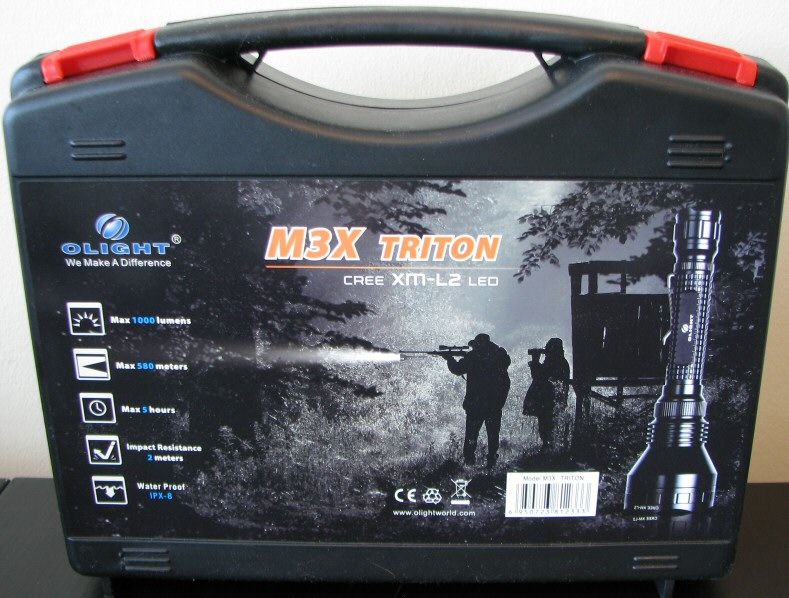
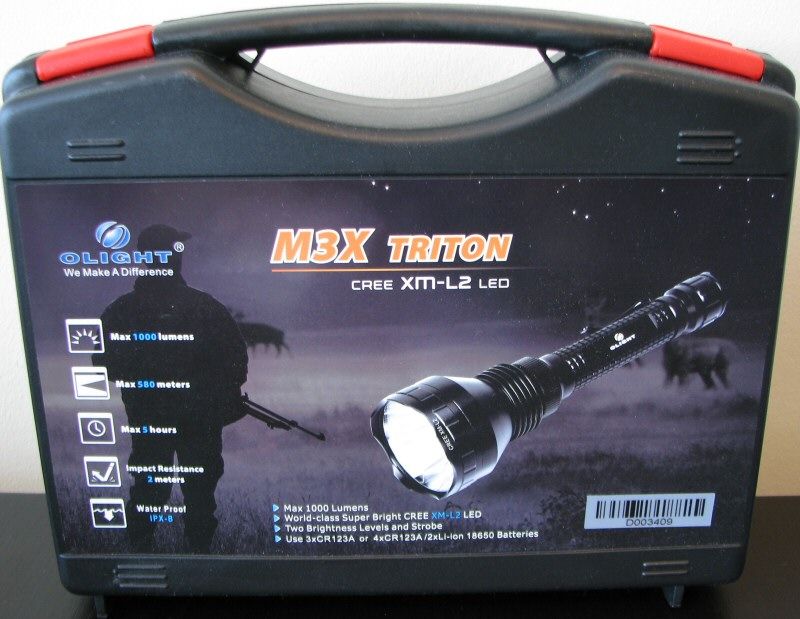
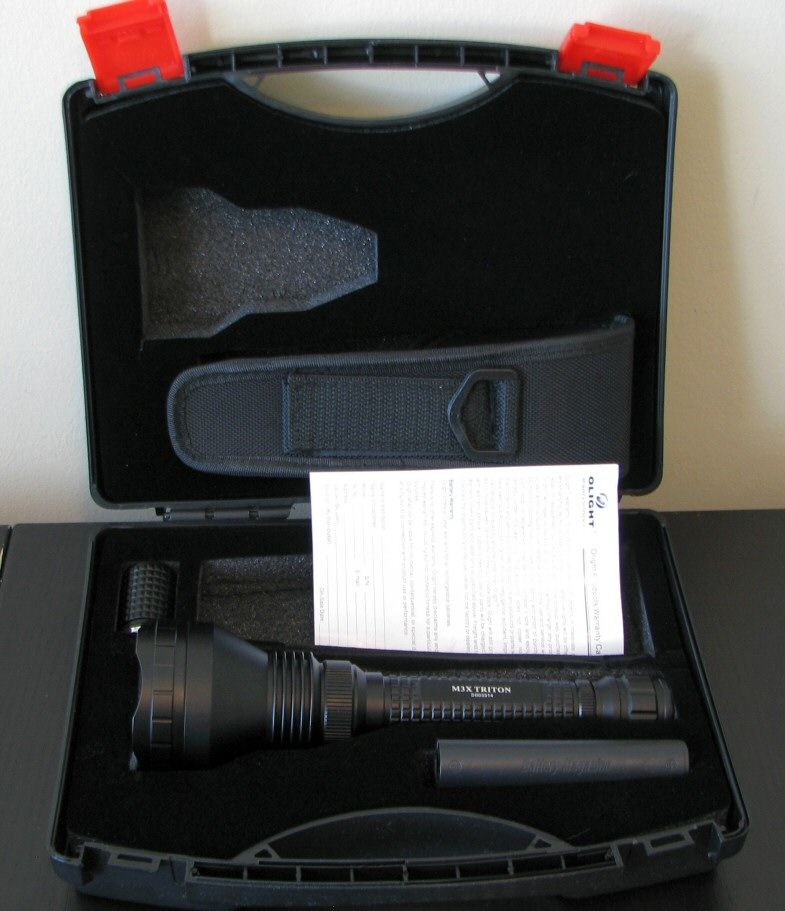
The M3X comes in a presentation-style plastic carrying case, similar to the other M-series lights from Olight. Inside everything is firmly secured in cut-out foam. You will find the light with battery extender tube, manual, warranty card, battery carrier, spare o-rings, and belt holster.
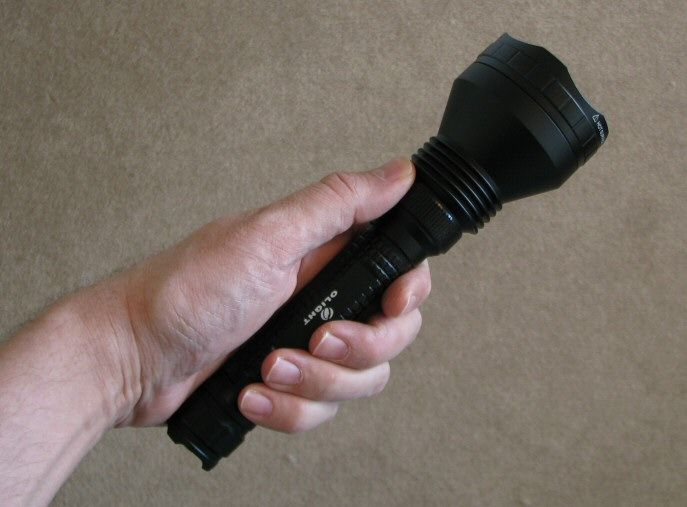

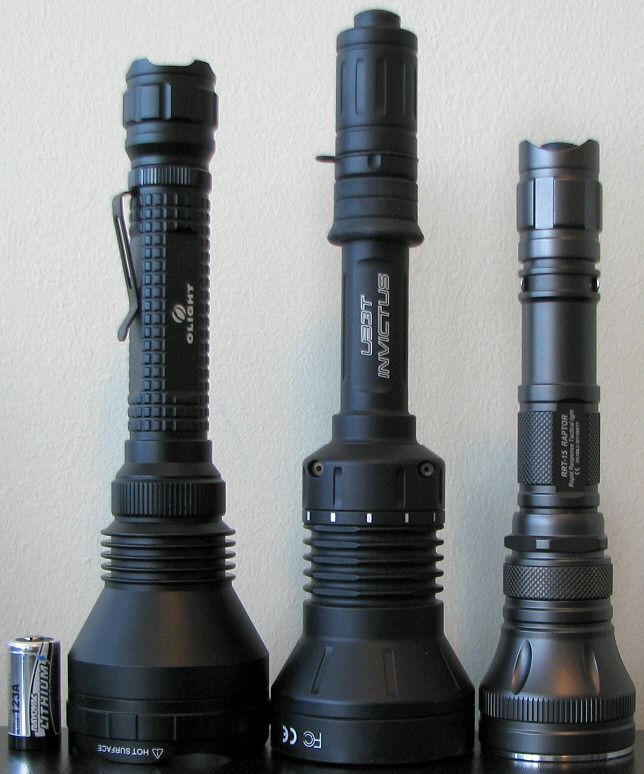
From left to right: CR123A; Olight M3X; Surefire UB3T; Jetbeam RRT-15.
With battery extender in place:
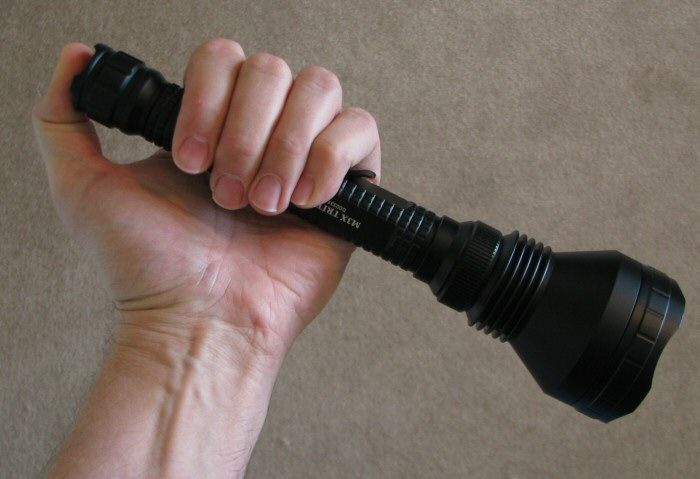
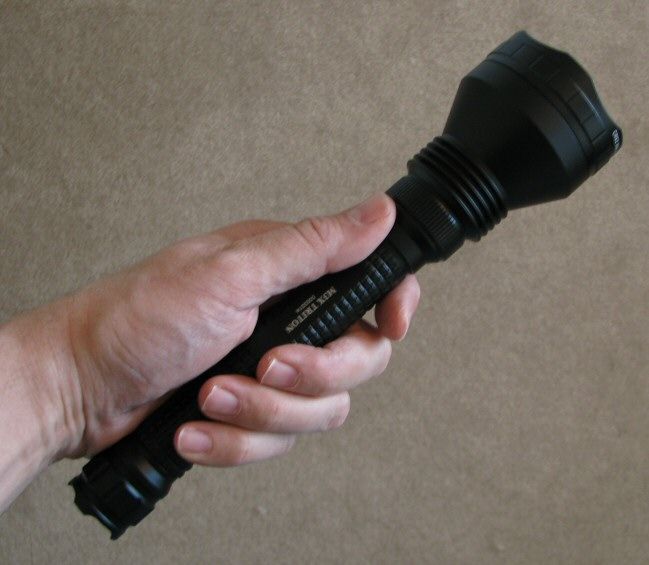
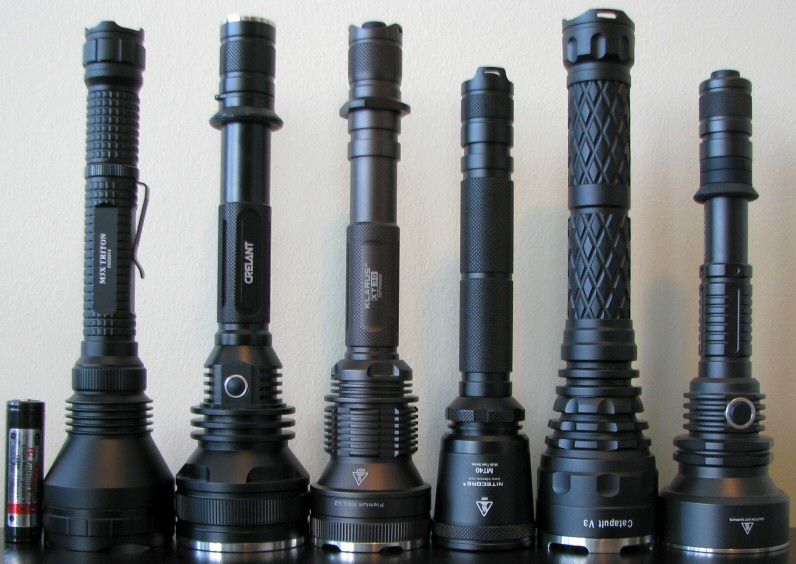
From left to right: AW Protected 18650; Olight M3X; Crelant 7G5CS; Klarus XT-30; Nitecore MT40; Thrunite Catapult V3; Sunwayman T40CS.
All dimensions directly measured, and given with no batteries installed:
Olight M3X no Extender: Weight: 260.9g, Length 211mm, Width (bezel): 62.3mm
Olight M3X with Extender: Weight 277.8g, Length 244mm, Width (bezel): 62.3mm
Olight M31 no Extender: Weight: 258.1g, Length 209mm, Width (bezel): 62.3mm
Olight M31 with Extender: Weight 275.1g, Length 245mm, Width (bezel): 62.3mm
Crelant 7G5CS: Weight: 334.5g, Length: 247mm Width (bezel): 64.0mm
Eagletac GX25L2: Weight: 198.3g (with battery pack: 290.1g), Length: 224mm, Width (bezel): 39.5mm
Eagletac SX25L2: Weight: 279.4g (with battery pack: 470.3g), Length: 239mm, Width (bezel): 47.0mm
Klarus XT30: Weight: 283.1g, Length: 247mm, Width (bezel): 58.0mm
Niwalker 750N1: Weight: 408.0g, Length: 269mm, Width (bezel): 58.6mm
Sunwayman T40CS: Weight: 296.7g, Length 227, Width (bezel): 63.5mm
Thrunite Catapult V3: Weight: 434.8g, Length: 254mm, Width (bezel) 58.0mm, Width (tailcap) 35.1mm.
The M3X has the same basic dimensions as the earlier M31 and M3X models, with a fairly wide head for this class.
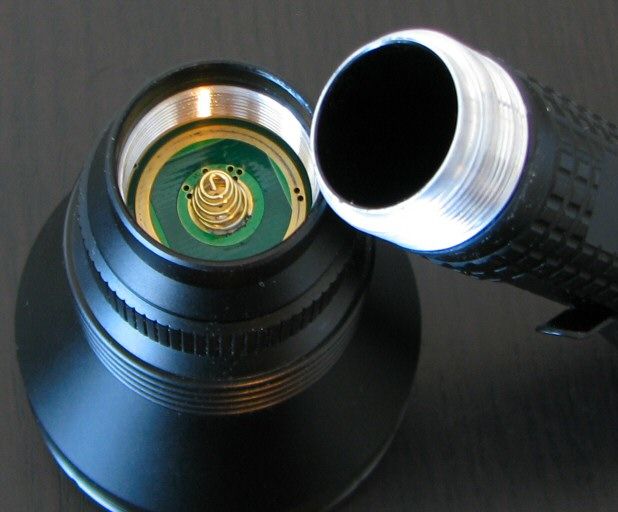
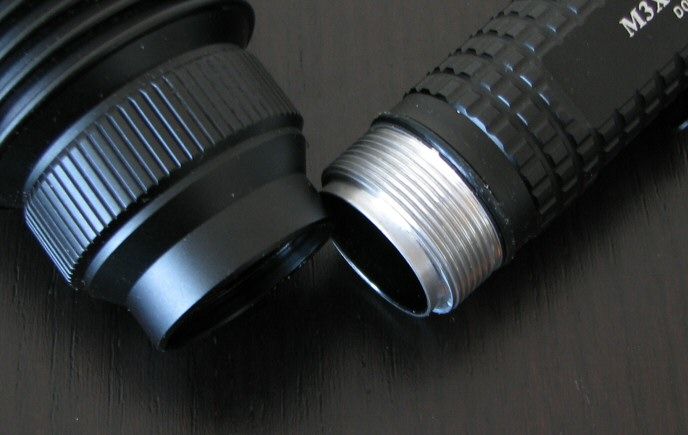
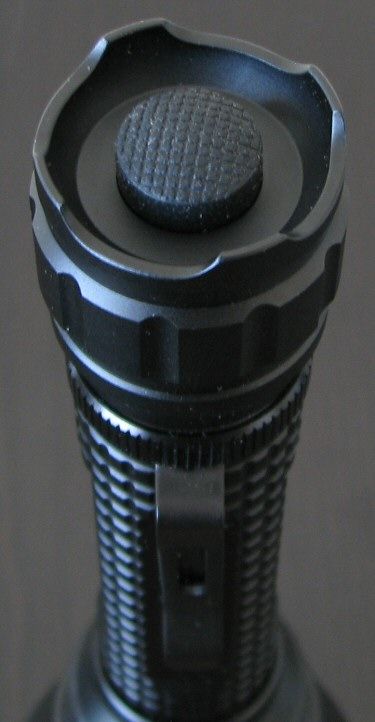
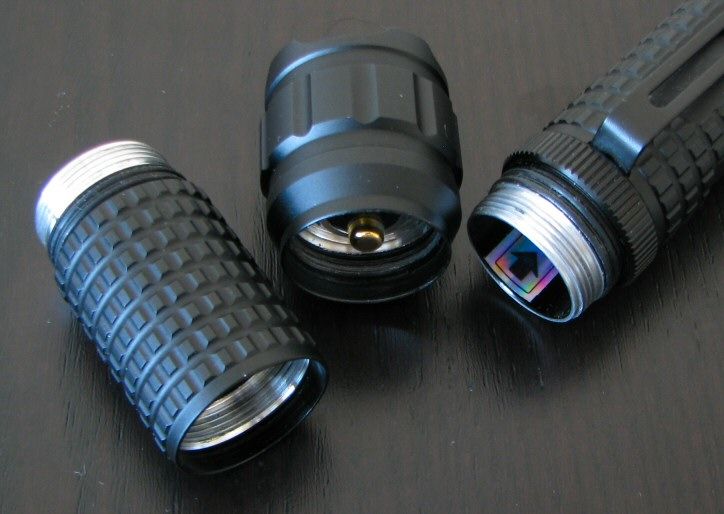

Physically, the build of the M3X hasn't really changed over the years. The M3X comes with matte finish type-III (hard) anodizing, in black. Rather than traditional knurling, the M3X continues to have the trademark Olight raised checkered pattern to help with grip. I typically find Olight lettering is bright and clear, and the M3X is no exception.
Screw threads are not anodized on the battery tubes, but there is anodizing on the tailcap screw threads. So lock-out is possible, although it may not be as robust as where both sets of matching threads are anodized.
The attached clip can be removed by unscrewing the retaining ring above it and pulling the clip off. The cover hides the attachment point in use.
The tailcap switch is a typical forward clicky, with good feel. Both the bezel opening and tailcap have raised scalloped edges. Like earlier lights, the M3X can also tailstand.
The included 3xCR123A/RCR battery holder is optional – you don't need to use it in this configuration, but it does remove battery rattle if you choose to. The bore width of the body tube is wide enough to accommodate protected 18500/18650, so thinner CR123A cells are prone to some rattle. At the very least, it makes a good storage holder for an extra set of cells.
Note the spring in the head, so high capacity flat-top batteries can be used. All my 18650 cells fit, but some of the longer cells seemed to be under a fair amount of tension.
M3X XM-L2 T6:
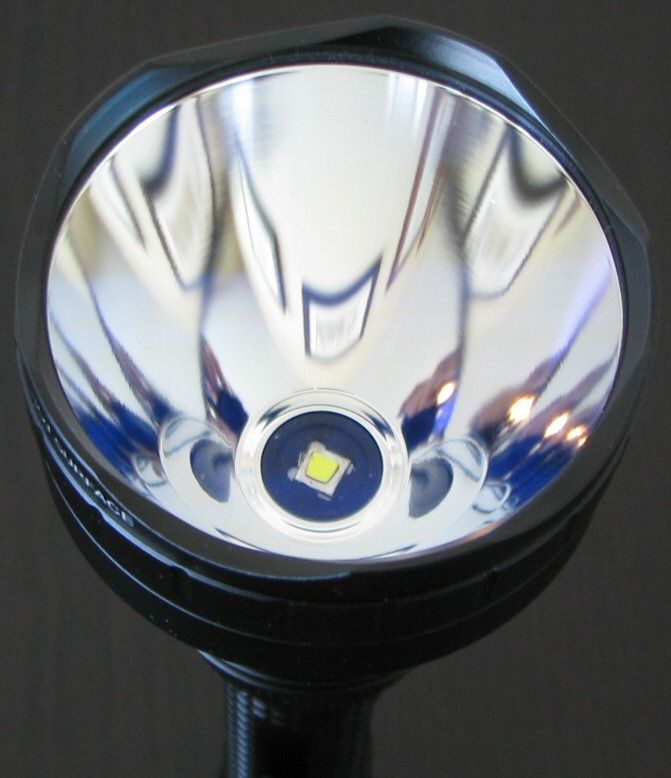
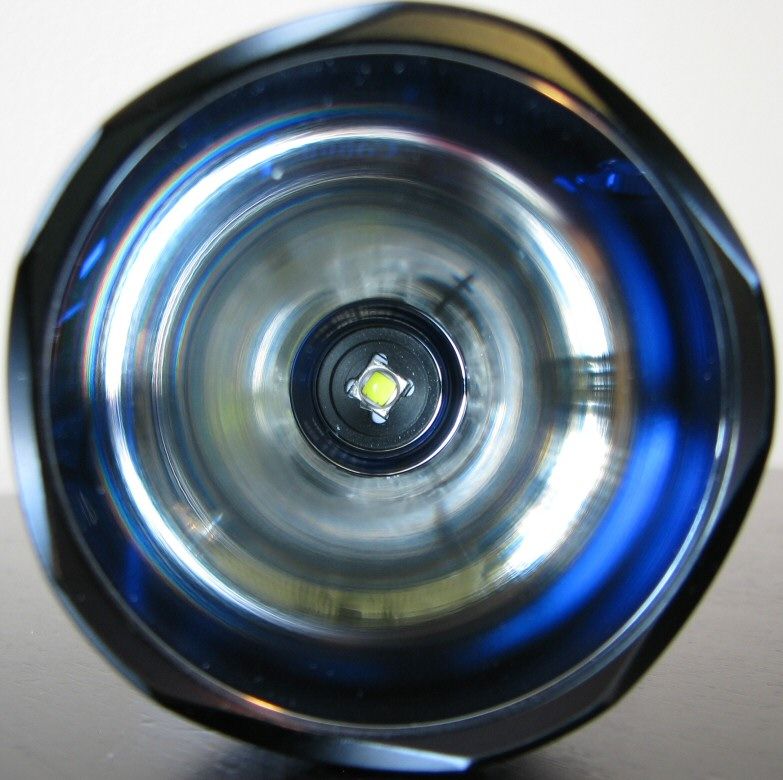

As before, reflector is smooth, and both wide and deep. Coupled with the XM-L2 emitter Cool White emitter (which was well centered on my sample), I would expect very good throw.
Note that you can distinguish the XM-L2 (shown above) from the original XM-L by the lack of bond wires over the die surface now, and the use of a silver mask (instead of green) outside the die/dome area. In case you are wondering, here is what the original SST-50-equipped M31 looked like:
M31 SST-50:
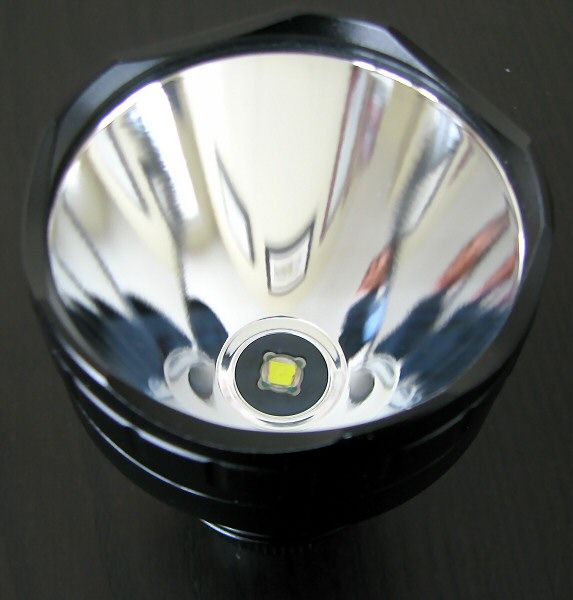
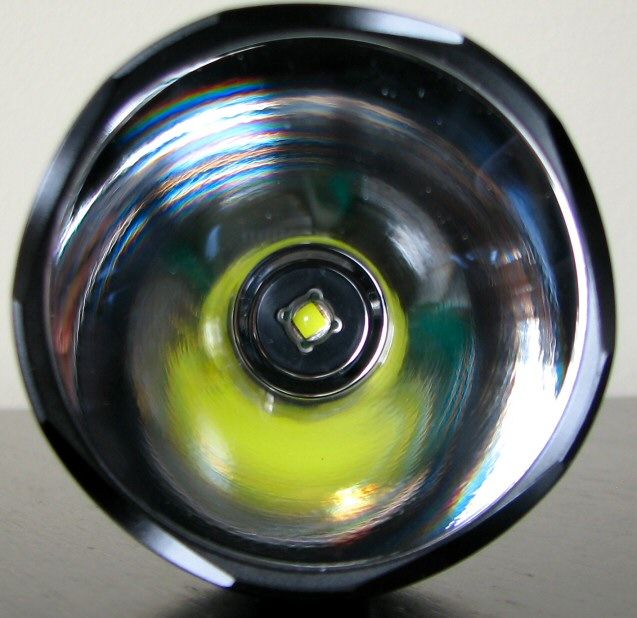
User Interface
User interface has been updated from the original M31, but I'm not sure when this change occurred among the M3X models.
As before, turn the light on/off by the tailcap forward clicky switch (press for momentary, click for locked-on).
You choose output mode by the position of the head – tight for Hi, loose for Lo. You access strobe by doing a loosen/tighten or tighten/loosen head switch in under one second. There is no mode memory for Strobe – upon turning off/on, the light always returns to the defined constant output head state.
On the previous M31, you would do loosen/tighten switches of the head to move through all the output states (Lo > Med > Hi > Strobe, in sequence).
Video:
For information on the light, including the build and user interface, please see my video overview:
Video was recorded in 720p, but YouTube typically defaults to 360p. Once the video is running, you can click on the configuration settings icon and select the higher 480p to 720p options. You can also run full-screen.
As with all my videos, I recommend you have annotations turned on. I commonly update the commentary with additional information or clarifications before publicly releasing the video.
PWM/Strobe
As always, there is no sign of PWM at any output level – The M3X is current-controlled like its predecessors.
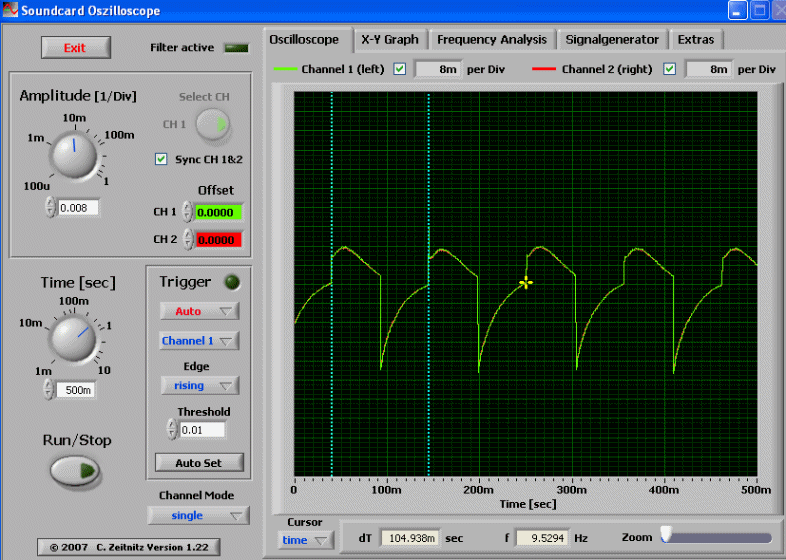
The strobe is a fairly typical fast "tactical" strobe, of 9.5Hz frequency (as before).
Beamshots:
For white-wall beamshots below, all lights are on Max output on 2x AW protected 18650 batteries. Lights are about ~0.75 meter from a white wall (with the camera ~1.25 meters back from the wall). Automatic white balance on the camera, to minimize tint differences.
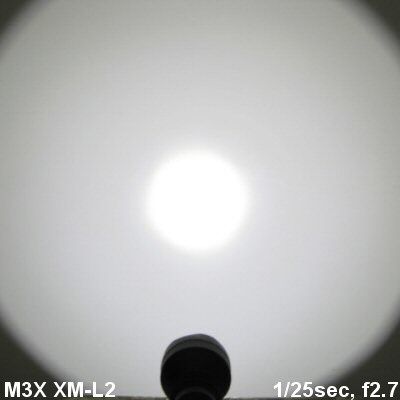
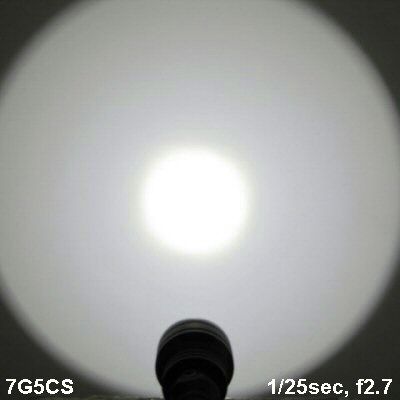
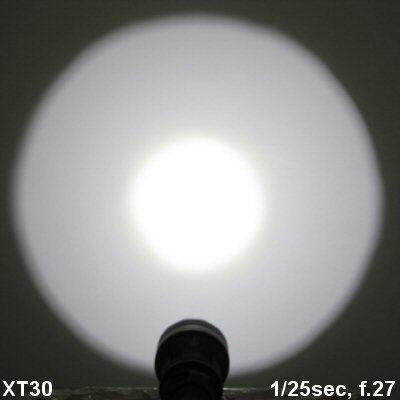

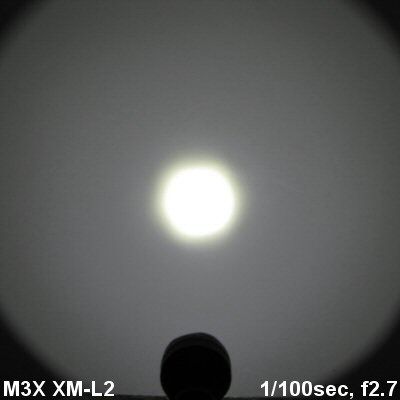
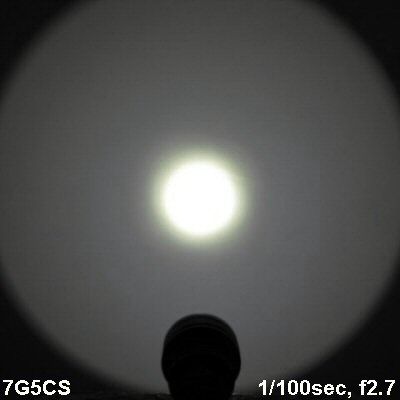
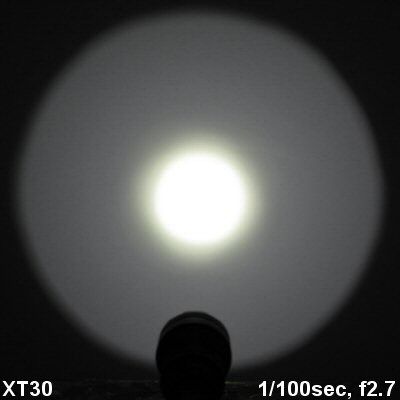
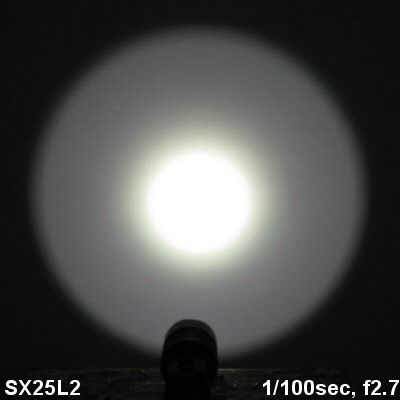
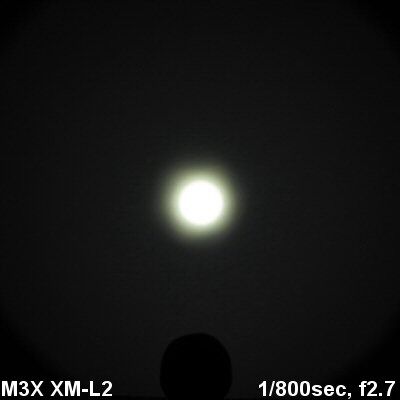
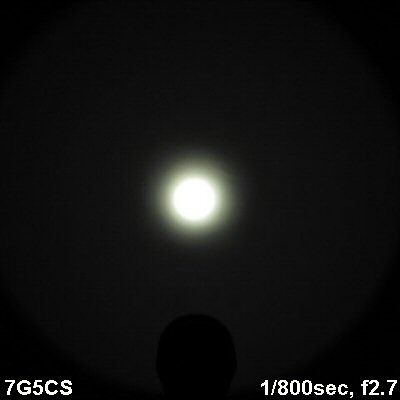
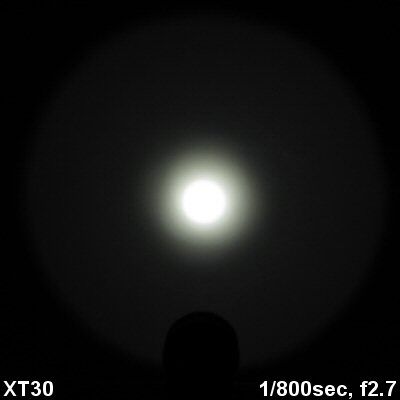
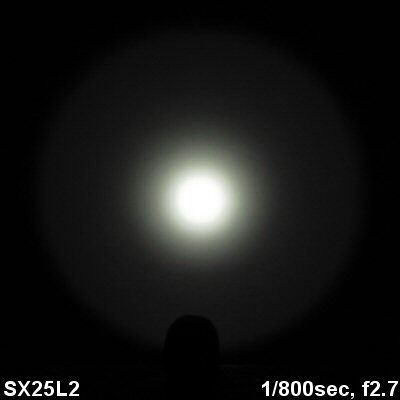
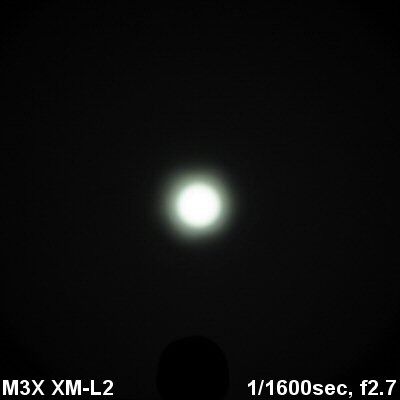
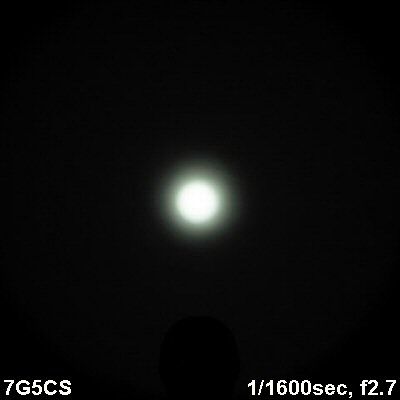
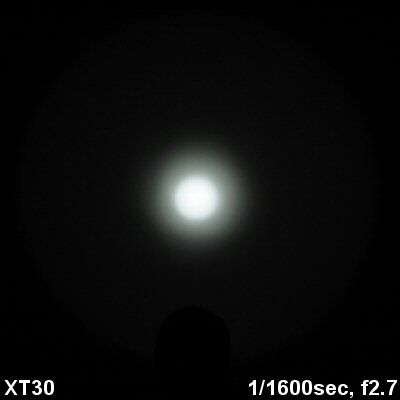
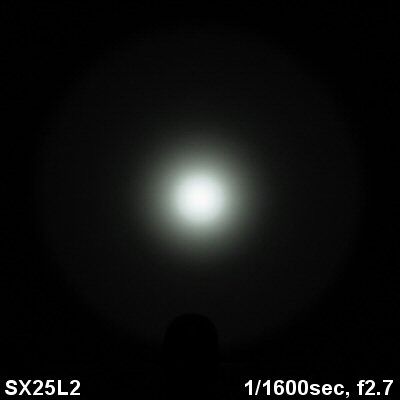
The M3X has a very wide spillbeam for this class, with a sharply defined hotspot. This is the classic "thrower" style, and you can probably tell from the above that this light will throw far.
Of course, the true test will be in outdoor shots. The snow is nearly gone here, so I should be able to get to these soon. In the meantime, here are some indoor shots. These will at least allow you to compare the throw and spill of the lights. For your reference, the back of the couch is about 7 feet away (~2.3m) from the opening of the light, and the far wall is about 18 feet away (~5.9m). Below I am showing a series of exposures, to allow you to better compare hotspot and spill.
The snow is nearly gone here, so I should be able to get to these soon. In the meantime, here are some indoor shots. These will at least allow you to compare the throw and spill of the lights. For your reference, the back of the couch is about 7 feet away (~2.3m) from the opening of the light, and the far wall is about 18 feet away (~5.9m). Below I am showing a series of exposures, to allow you to better compare hotspot and spill.
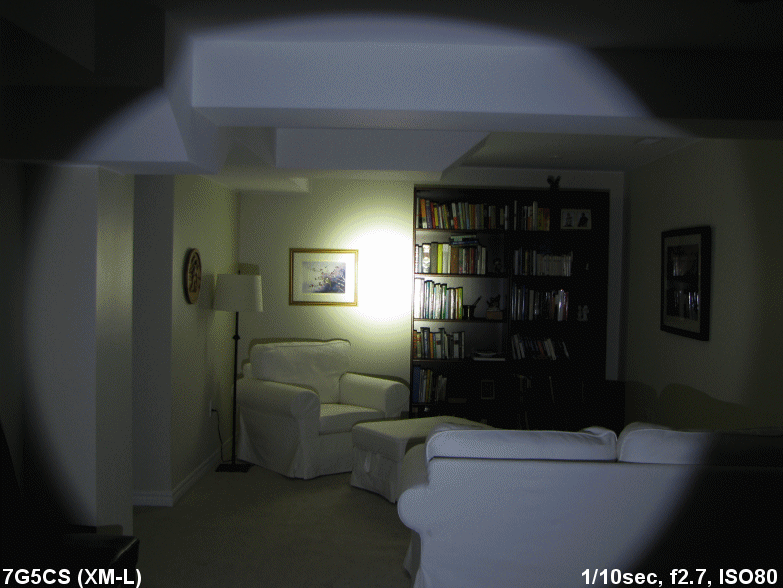
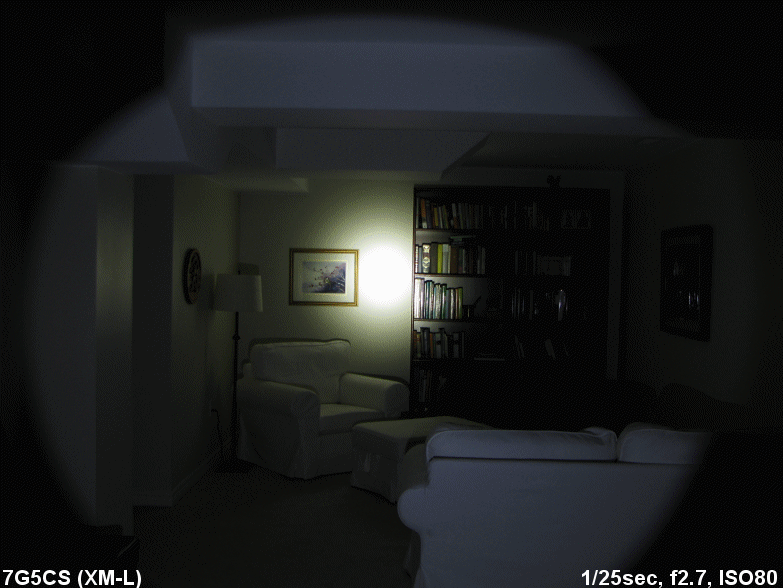
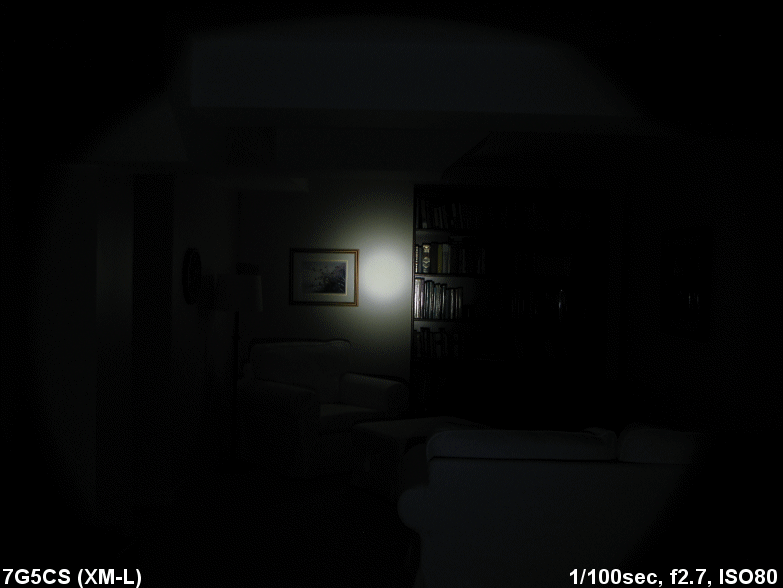
The M3X definitely has the brightest (and largest) hotspot among by best 2x18650 XM-L-based throwers. :thumbsup:
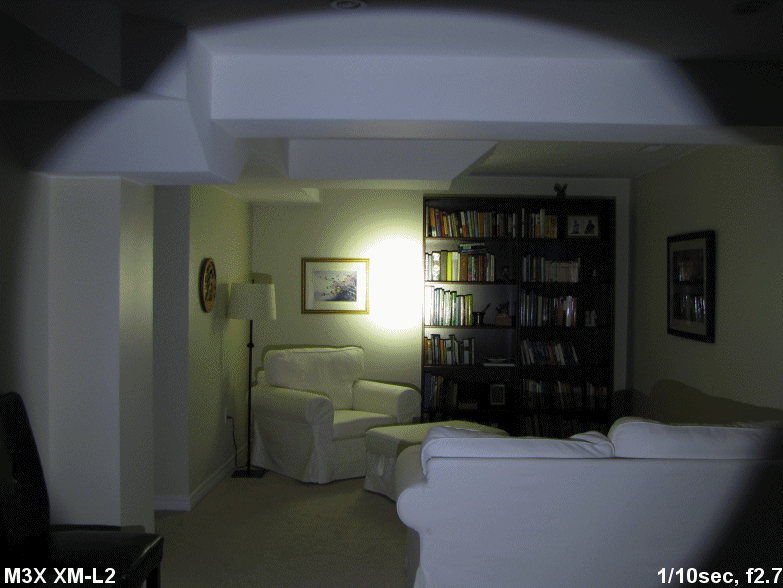

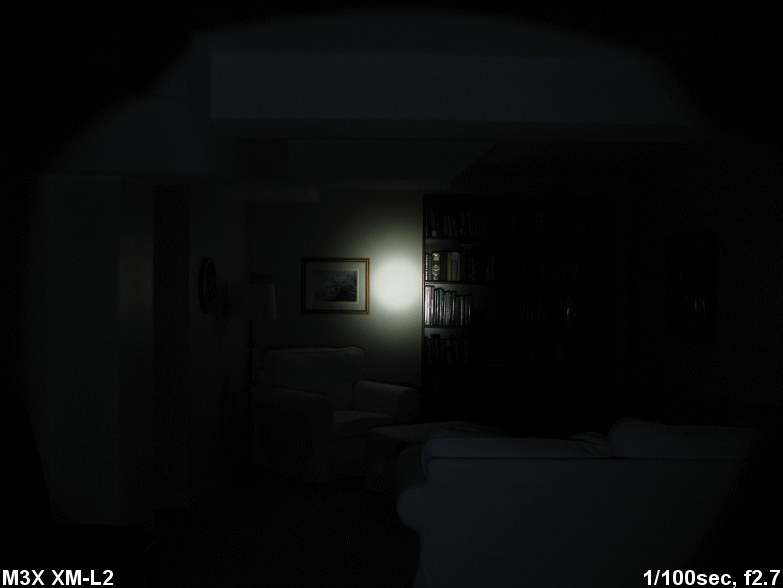
I've thrown another XM-L2 light into the mix above (Eagletac SX25L2), but clearly it can't compete with the standard head. Eagletac will be sending me Turbo heads for those series, so we'll see how they do when they arrive.
UPDATE JUNE 18, 2003: Below see a comparison of the M3X to the Eagletac SX25L2 Turbo head, and ArmyTek Barracuda - two recent XM-L2 lights.
For outdoor beamshots, these are all done in the style of my earlier 100-yard round-up review. Please see that thread for a discussion of the topography (i.e. the road dips in the distance, to better show you the corona in the mid-ground).
FYI, any "streaks" you see across the images are bug-trails. Flying insects are often attracted to the bright lights, and their flight trails get captured as swirly streaks due to the long exposure time.
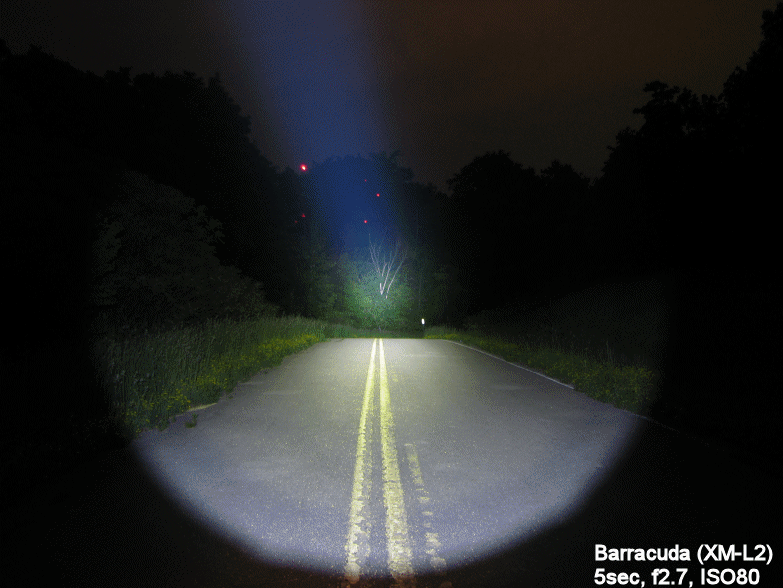
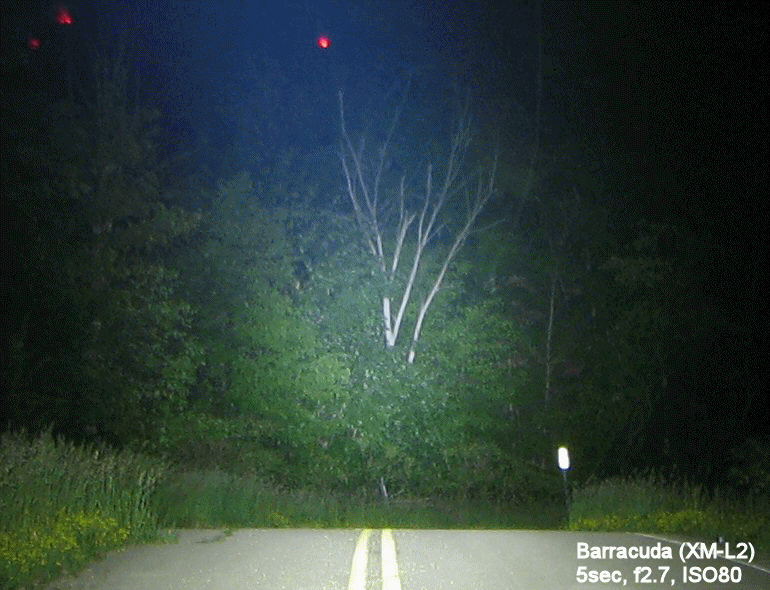
As you can see, the M3X is an outstanding thrower, with a wider spillbeam than the other lights (especially the Barracuda). The Barracuda has the highest centre beam lux throw in my collection at the moment, but the M3X XM-L2 is very close. Again, ignore any tint differences above – they are mainly due to the automatic white balance setting on the camera.
Testing Method:
All my output numbers are relative for my home-made light box setup, as described on my flashlightreviews.ca website. You can directly compare all my relative output values from different reviews - i.e. an output value of "10" in one graph is the same as "10" in another. All runtimes are done under a cooling fan, except for any extended run Lo/Min modes (i.e. >12 hours) which are done without cooling.
I have devised a method for converting my lightbox relative output values (ROV) to estimated Lumens. See my How to convert Selfbuilt's Lightbox values to Lumens thread for more info.
Throw/Output Summary Chart:
My summary tables are reported in a manner consistent with the ANSI FL-1 standard for flashlight testing. Please see http://www.flashlightreviews.ca/FL1.htm for a discussion, and a description of all the terms used in these tables. Effective July 2012, I have updated all my Peak Intensity/Beam Distance measures with a NIST-certified Extech EA31 lightmeter (orange highlights).
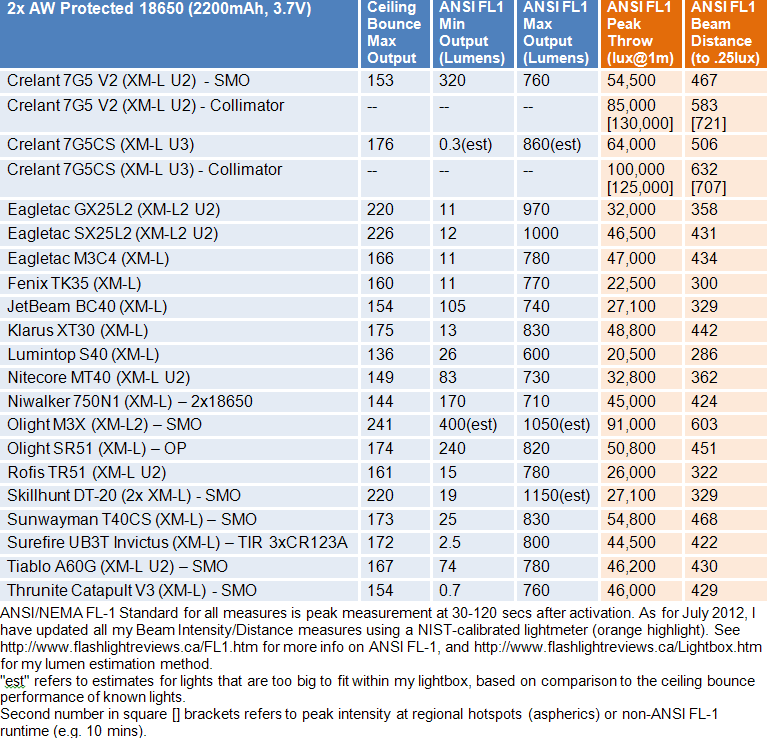
The Olight ANSI FL-1 output and throw specs for the M3X seem very good – my measures match them closely.
The 91,000cd center beam intensity makes this the furthest throwing reflector-based 2x18650 light in my collection at the moment. Only the aspherical (collimator) lights are able to beat it (and even there, not by much). oo:
oo:
XM-L2 vs XM-L
I realize all this emitter talk may seem confusing, especially for those that don't keep up on the fine details of LEDs.
Basically, these new XM-L2 emitters are very similar to the old XM-L, but built on a new process. Directly comparing back to XM-L is complicated by the more stringent testing and reporting measures Cree is now using for XM-L2 output binning. But there is actually an easy conversion - if you look up the Cree spec tables under the same conditions, you will see that the new XM-L2 bins are exactly two bin steps brighter than the same bin number on XM-L. So a XM-L2 T6 is basically the same thing as a XM-L U3. This is part of the reason for the switch to the new process - there is now more "headroom" on the new XM-L2 platform, and higher output XM-L2 emitters can ultimately be produced.
In terms of lumens though, you have to keep in mind how the binning process works. Given the ~7% range within each bin, this means that for any given specific XM-L2 sample could be anywhere from ~7-20% brighter than a comparably bin-numbered XM-L sample. This is presumably where that "up to" 20% brighter statement comes from in the Cree literature. But you need to keep in mind that on average, a XM-L2 T6 should be ~13% brighter than a XM-L T6, for example. You really have to think of these things statistically – the bins are a range, and you don't know where exactly in the range any given sample will fall.
But you need to keep in mind that on average, a XM-L2 T6 should be ~13% brighter than a XM-L T6, for example. You really have to think of these things statistically – the bins are a range, and you don't know where exactly in the range any given sample will fall.
Olight doesn't typically publish output bin specs for their lights, but they have confirmed with me that my M3X sample uses a T6 output bin.
Output/Runtime Graphs:

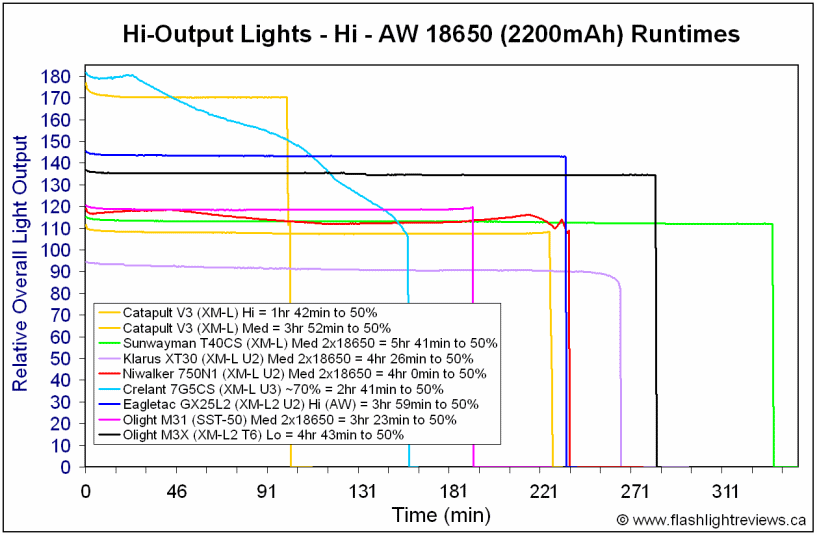
On max, the M3X has very high output for the class, with no sign of any sort of step-down. It is interesting to compare it to the original M31 – as you can tell from the 2x18650 runtimes above, the M31 was clearly driving its SST-50 emitter very hard (i.e. runtimes were relatively low for the class).
It is interesting to note that the "Lo" on the M3X is brighter than the "Med" mode of most other lights. Efficiency of the XM-L2-equipped M3X seems very similar overall to the Eagletac GX25L2, at all levels. Both Olight and Eagletac are known for their efficient current-controlled circuits.
Let's see how the Olight lights compare on 2x18500 (which fit into the light with the extender in place):
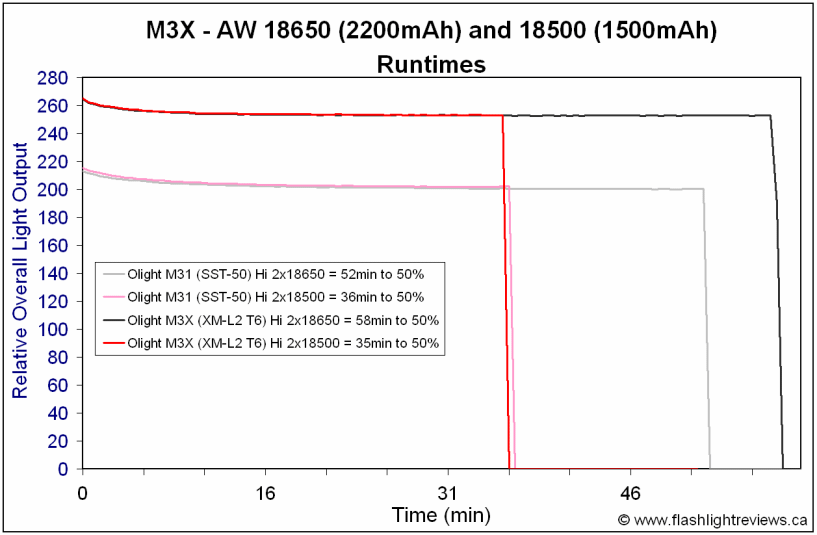
These lights are not well suited to 2x18500, given how hard they are driven on 2x Li-ion sources (i.e., you are better sticking with good capacity 18650 cells). But it's nice to know the option is there if you need it.
For the CR123A runs, I am comparing below the M3X and M31 to a number of 3xCR123A and 4xCR123A lights (with the 3x runs in dotted lines, 4x runs in solid).
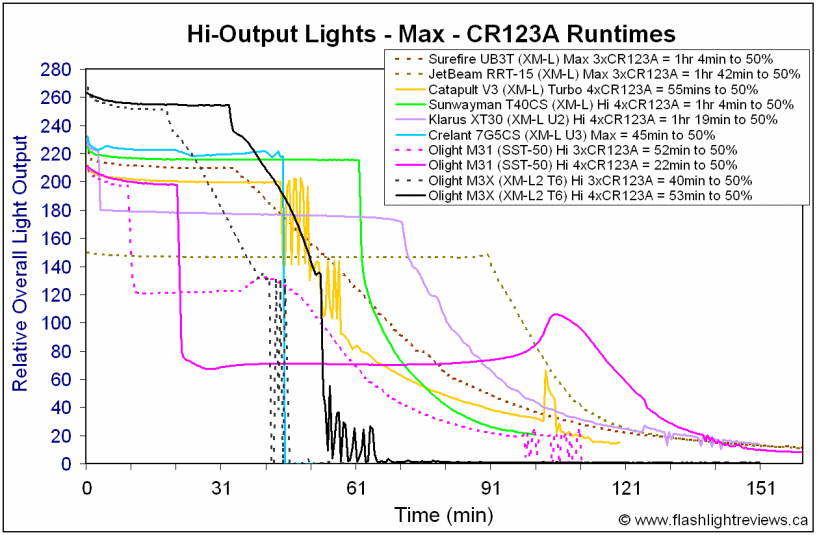
The Hi mode of my M3X performed better on CR123A primary batteries than my earlier M31.
But to understand why, I need to first explain the apparently unusual behavior of the M31 on 3x and 4x primary battery sources (i.e., those rapid dips and partial recoveries). The older M31 is driven high enough on Max to trip the PTC safety devices of most primary CR123A cells, when run over a sustained period.
Simply put, a PTC (Positive Temperature Coefficient) functions kind of like a resistor or circuit breaker, and is incorporated into every primary CR123A battery. Technically, they are thermistors – circuit devices whose resistance varies with temperature (in this case, resistance increases with temperature, aka a posistor). Battery PTCs are of the "switching" type, which means their resistance rises suddenly once a certain critical temperature is reached. I have previously observed that there are marked differences in the speed in which made-in-the-USA cells will trip compared to made-in-China cells (i.e., made-in-the-USA cells trip earlier). My CR123A testing is done with made-in-China Titanium Innovations cells, which tend not to trip as easily. This conclusion, based on extensive testing in another light, is thoroughly discussed in this thread.
The point is that once the temperature reaches a certain threshold (which varies according to the battery manufacturer), the PTC resistance rises and current limitation kicks in, causing a rapid drop in output. Over time, the temperature drops and the cells recover, showing an uptick in output. This is what you are seeing on the earlier M31 traces above, which was hard on all primary batteries (even on my more forgiving Titanium Innovation cells).
I am happy to report that the M3X doesn't seem to heat/drive the cells to the same level as the M31 (i.e., no sign of PTC engagement in these tests, using the same brand of cells as before). :thumbsup: That said, I can tell that the M3X current draw on Hi is still hard on the primary cells - I saw clear evidence of wrapper damage near the PTCs after these tests. Note that this wrapper damage issue is not unique to this light - I've seen signs of this before on many heavily-driven 2x and 3x/4xCR123A lights. But it suggests that had I been using made-in-the-USA cells (which trip earlier), it is possible that PTCs may have engaged to limit the current on the M3X as well.
As such, I continue to recommend you do not run any of the M3x-series lights on Hi for extended periods on 3x or 4xCR123A cells. I would also recommend Olight introduce a step-down feature in this light, as they have in a number of their other models (e.g. the recent M22 and S20).
As with my other recent Olight lights, ANSI FL-1 runtime specs are consistent with my results. Recall that I use lower capacity 2200mAh 18650 cells, and that the FL-1 standard calls for time to 10% output (not 50%, as reported above).
Recall that I use lower capacity 2200mAh 18650 cells, and that the FL-1 standard calls for time to 10% output (not 50%, as reported above).
Potential Issues
All M3x-series lights are heavily driven on Hi, with no automatic step-down feature. As such, I recommend you do not run the light on Hi for extended periods of time on primary CR123A or 2x18500. On Hi, the light is really best suited for 2x18650.
Light lacks a true Lo mode (i.e., the included Lo is more like the "Med" mode of most lights in this class).
There is no bundled diffuser with the M3X, unlike other M-series Olights. However, the standard Olight filter from SR50/SR51 fits and works perfectly.
Preliminary Observations
First, the headline: the XM-L2-equipped M3X is the furthest throwing reflector-based 2x18650 light in my collection at the moment. :wave:
It is an impressive level of throw, coming close to some aspherics I've seen in this size. The M3x series has been around for a while now, and Olight has clearly optimized it for max output and throw in this class. I am happy to report that the M3X's ANSI FL-1 specs for output, throw and runtime appear to be very accurate.
Those familiar with the M3x build will find little has changed in external appearance. User Interface has been simplified from the earlier M31, with just two constant output modes now (set by head tight or loose) and "hidden" strobe (accessed by a head twist). :thumbsup: This is different from earlier models, where head twists were used to change between three constant output modes and strobe (in sequence). I suspect most will find the new interface an improvement, but it does mean you lack a true Lo mode now.
I have always liked the wide battery flexibility of this series, both with the extender (i.e. 2x18650, 4xCR123A) and without it (i.e. 2x18500, 3xCR123A). But as I have noted in previous model reviews, this series is highly-driven on Hi (with no sign of step-down). As such, you may want to take care not to run the light in extended periods on CR123A or lower capacity 18500s (i.e., best to use good quality, high-capacity 2x18650 for extended Hi mode runs).
At the end of the day, this series remains a torch-bearer (pardon the pun) for the reflector-based heavy-throw class. With appropriate common-sense about battery configurations on Hi, I think you will find the new XM-L2-based M3X is worth consideration in the massive throw class.
for the reflector-based heavy-throw class. With appropriate common-sense about battery configurations on Hi, I think you will find the new XM-L2-based M3X is worth consideration in the massive throw class.
----
M3X was provided by Olight for this review.



It was a little over two years ago that I review the first model in the M3x-series of lights from Olight – the SST-50-based M31. This was quickly replaced with by the XM-L-based M3X, which now sports the new XM-L2 emitter (to be reviewed here).
Physically not much has changed, but let's put the new XM-L2 version through its paces and see how it compares to some other modern "throw" lights in my collection.
Manufacturer Reported Specifications:
(note: as always, these are simply what the manufacturer provides – scroll down to see my actual testing results).
- Assembled with the latest Cree XM-L2 LED [Reviewer's note: Olight informs me my sample is a T6 output bin]
- Two brightness levels and Strobe
- Output/Runtime: Hi 1000lm (1hr 20min), Lo 300lm (5hr)
- Supports 3x or 4x CR123A, or 2x18650 Li-ions
- Beam intensity: 84,100cd
- Beam distance: 580m
- Impact resistance: 2m
- The Crenellated bezel and tail designed for close combat
- ATM (Active Thermal Management System) prevent flashlights, LED and other components from high temperature, it raises the reliability of the product.
- Smooth reflector offers perfect beam and long throw
- Shatter and scratch resistant and anti-reflective double coated ultra clear lens,
light transmission rate of 99% - Highly water resistant to IPX-8
- Removable stainless steel clip
- Dimensions: 1211mm / 8.30" (L) x 63mm / 2.48" (D)
- Weight: 266g / 9.38oz (without battery)
- Included accessories: Extended Tube*1; Holster*1; Battery Magazine *1; O-ring*4
- MSRP: ~$130



The M3X comes in a presentation-style plastic carrying case, similar to the other M-series lights from Olight. Inside everything is firmly secured in cut-out foam. You will find the light with battery extender tube, manual, warranty card, battery carrier, spare o-rings, and belt holster.



From left to right: CR123A; Olight M3X; Surefire UB3T; Jetbeam RRT-15.
With battery extender in place:



From left to right: AW Protected 18650; Olight M3X; Crelant 7G5CS; Klarus XT-30; Nitecore MT40; Thrunite Catapult V3; Sunwayman T40CS.
All dimensions directly measured, and given with no batteries installed:
Olight M3X no Extender: Weight: 260.9g, Length 211mm, Width (bezel): 62.3mm
Olight M3X with Extender: Weight 277.8g, Length 244mm, Width (bezel): 62.3mm
Olight M31 no Extender: Weight: 258.1g, Length 209mm, Width (bezel): 62.3mm
Olight M31 with Extender: Weight 275.1g, Length 245mm, Width (bezel): 62.3mm
Crelant 7G5CS: Weight: 334.5g, Length: 247mm Width (bezel): 64.0mm
Eagletac GX25L2: Weight: 198.3g (with battery pack: 290.1g), Length: 224mm, Width (bezel): 39.5mm
Eagletac SX25L2: Weight: 279.4g (with battery pack: 470.3g), Length: 239mm, Width (bezel): 47.0mm
Klarus XT30: Weight: 283.1g, Length: 247mm, Width (bezel): 58.0mm
Niwalker 750N1: Weight: 408.0g, Length: 269mm, Width (bezel): 58.6mm
Sunwayman T40CS: Weight: 296.7g, Length 227, Width (bezel): 63.5mm
Thrunite Catapult V3: Weight: 434.8g, Length: 254mm, Width (bezel) 58.0mm, Width (tailcap) 35.1mm.
The M3X has the same basic dimensions as the earlier M31 and M3X models, with a fairly wide head for this class.





Physically, the build of the M3X hasn't really changed over the years. The M3X comes with matte finish type-III (hard) anodizing, in black. Rather than traditional knurling, the M3X continues to have the trademark Olight raised checkered pattern to help with grip. I typically find Olight lettering is bright and clear, and the M3X is no exception.
Screw threads are not anodized on the battery tubes, but there is anodizing on the tailcap screw threads. So lock-out is possible, although it may not be as robust as where both sets of matching threads are anodized.
The attached clip can be removed by unscrewing the retaining ring above it and pulling the clip off. The cover hides the attachment point in use.
The tailcap switch is a typical forward clicky, with good feel. Both the bezel opening and tailcap have raised scalloped edges. Like earlier lights, the M3X can also tailstand.
The included 3xCR123A/RCR battery holder is optional – you don't need to use it in this configuration, but it does remove battery rattle if you choose to. The bore width of the body tube is wide enough to accommodate protected 18500/18650, so thinner CR123A cells are prone to some rattle. At the very least, it makes a good storage holder for an extra set of cells.
Note the spring in the head, so high capacity flat-top batteries can be used. All my 18650 cells fit, but some of the longer cells seemed to be under a fair amount of tension.
M3X XM-L2 T6:



As before, reflector is smooth, and both wide and deep. Coupled with the XM-L2 emitter Cool White emitter (which was well centered on my sample), I would expect very good throw.
Note that you can distinguish the XM-L2 (shown above) from the original XM-L by the lack of bond wires over the die surface now, and the use of a silver mask (instead of green) outside the die/dome area. In case you are wondering, here is what the original SST-50-equipped M31 looked like:
M31 SST-50:


User Interface
User interface has been updated from the original M31, but I'm not sure when this change occurred among the M3X models.
As before, turn the light on/off by the tailcap forward clicky switch (press for momentary, click for locked-on).
You choose output mode by the position of the head – tight for Hi, loose for Lo. You access strobe by doing a loosen/tighten or tighten/loosen head switch in under one second. There is no mode memory for Strobe – upon turning off/on, the light always returns to the defined constant output head state.
On the previous M31, you would do loosen/tighten switches of the head to move through all the output states (Lo > Med > Hi > Strobe, in sequence).
Video:
For information on the light, including the build and user interface, please see my video overview:
Video was recorded in 720p, but YouTube typically defaults to 360p. Once the video is running, you can click on the configuration settings icon and select the higher 480p to 720p options. You can also run full-screen.
As with all my videos, I recommend you have annotations turned on. I commonly update the commentary with additional information or clarifications before publicly releasing the video.
PWM/Strobe
As always, there is no sign of PWM at any output level – The M3X is current-controlled like its predecessors.

The strobe is a fairly typical fast "tactical" strobe, of 9.5Hz frequency (as before).
Beamshots:
For white-wall beamshots below, all lights are on Max output on 2x AW protected 18650 batteries. Lights are about ~0.75 meter from a white wall (with the camera ~1.25 meters back from the wall). Automatic white balance on the camera, to minimize tint differences.
















The M3X has a very wide spillbeam for this class, with a sharply defined hotspot. This is the classic "thrower" style, and you can probably tell from the above that this light will throw far.
Of course, the true test will be in outdoor shots.



The M3X definitely has the brightest (and largest) hotspot among by best 2x18650 XM-L-based throwers. :thumbsup:



I've thrown another XM-L2 light into the mix above (Eagletac SX25L2), but clearly it can't compete with the standard head. Eagletac will be sending me Turbo heads for those series, so we'll see how they do when they arrive.
UPDATE JUNE 18, 2003: Below see a comparison of the M3X to the Eagletac SX25L2 Turbo head, and ArmyTek Barracuda - two recent XM-L2 lights.
For outdoor beamshots, these are all done in the style of my earlier 100-yard round-up review. Please see that thread for a discussion of the topography (i.e. the road dips in the distance, to better show you the corona in the mid-ground).
FYI, any "streaks" you see across the images are bug-trails. Flying insects are often attracted to the bright lights, and their flight trails get captured as swirly streaks due to the long exposure time.


As you can see, the M3X is an outstanding thrower, with a wider spillbeam than the other lights (especially the Barracuda). The Barracuda has the highest centre beam lux throw in my collection at the moment, but the M3X XM-L2 is very close. Again, ignore any tint differences above – they are mainly due to the automatic white balance setting on the camera.
Testing Method:
All my output numbers are relative for my home-made light box setup, as described on my flashlightreviews.ca website. You can directly compare all my relative output values from different reviews - i.e. an output value of "10" in one graph is the same as "10" in another. All runtimes are done under a cooling fan, except for any extended run Lo/Min modes (i.e. >12 hours) which are done without cooling.
I have devised a method for converting my lightbox relative output values (ROV) to estimated Lumens. See my How to convert Selfbuilt's Lightbox values to Lumens thread for more info.
Throw/Output Summary Chart:
My summary tables are reported in a manner consistent with the ANSI FL-1 standard for flashlight testing. Please see http://www.flashlightreviews.ca/FL1.htm for a discussion, and a description of all the terms used in these tables. Effective July 2012, I have updated all my Peak Intensity/Beam Distance measures with a NIST-certified Extech EA31 lightmeter (orange highlights).

The Olight ANSI FL-1 output and throw specs for the M3X seem very good – my measures match them closely.
The 91,000cd center beam intensity makes this the furthest throwing reflector-based 2x18650 light in my collection at the moment. Only the aspherical (collimator) lights are able to beat it (and even there, not by much).
XM-L2 vs XM-L
I realize all this emitter talk may seem confusing, especially for those that don't keep up on the fine details of LEDs.
Basically, these new XM-L2 emitters are very similar to the old XM-L, but built on a new process. Directly comparing back to XM-L is complicated by the more stringent testing and reporting measures Cree is now using for XM-L2 output binning. But there is actually an easy conversion - if you look up the Cree spec tables under the same conditions, you will see that the new XM-L2 bins are exactly two bin steps brighter than the same bin number on XM-L. So a XM-L2 T6 is basically the same thing as a XM-L U3. This is part of the reason for the switch to the new process - there is now more "headroom" on the new XM-L2 platform, and higher output XM-L2 emitters can ultimately be produced.
In terms of lumens though, you have to keep in mind how the binning process works. Given the ~7% range within each bin, this means that for any given specific XM-L2 sample could be anywhere from ~7-20% brighter than a comparably bin-numbered XM-L sample. This is presumably where that "up to" 20% brighter statement comes from in the Cree literature.
Olight doesn't typically publish output bin specs for their lights, but they have confirmed with me that my M3X sample uses a T6 output bin.
Output/Runtime Graphs:


On max, the M3X has very high output for the class, with no sign of any sort of step-down. It is interesting to compare it to the original M31 – as you can tell from the 2x18650 runtimes above, the M31 was clearly driving its SST-50 emitter very hard (i.e. runtimes were relatively low for the class).
It is interesting to note that the "Lo" on the M3X is brighter than the "Med" mode of most other lights. Efficiency of the XM-L2-equipped M3X seems very similar overall to the Eagletac GX25L2, at all levels. Both Olight and Eagletac are known for their efficient current-controlled circuits.
Let's see how the Olight lights compare on 2x18500 (which fit into the light with the extender in place):

These lights are not well suited to 2x18500, given how hard they are driven on 2x Li-ion sources (i.e., you are better sticking with good capacity 18650 cells). But it's nice to know the option is there if you need it.
For the CR123A runs, I am comparing below the M3X and M31 to a number of 3xCR123A and 4xCR123A lights (with the 3x runs in dotted lines, 4x runs in solid).

The Hi mode of my M3X performed better on CR123A primary batteries than my earlier M31.
But to understand why, I need to first explain the apparently unusual behavior of the M31 on 3x and 4x primary battery sources (i.e., those rapid dips and partial recoveries). The older M31 is driven high enough on Max to trip the PTC safety devices of most primary CR123A cells, when run over a sustained period.
Simply put, a PTC (Positive Temperature Coefficient) functions kind of like a resistor or circuit breaker, and is incorporated into every primary CR123A battery. Technically, they are thermistors – circuit devices whose resistance varies with temperature (in this case, resistance increases with temperature, aka a posistor). Battery PTCs are of the "switching" type, which means their resistance rises suddenly once a certain critical temperature is reached. I have previously observed that there are marked differences in the speed in which made-in-the-USA cells will trip compared to made-in-China cells (i.e., made-in-the-USA cells trip earlier). My CR123A testing is done with made-in-China Titanium Innovations cells, which tend not to trip as easily. This conclusion, based on extensive testing in another light, is thoroughly discussed in this thread.
The point is that once the temperature reaches a certain threshold (which varies according to the battery manufacturer), the PTC resistance rises and current limitation kicks in, causing a rapid drop in output. Over time, the temperature drops and the cells recover, showing an uptick in output. This is what you are seeing on the earlier M31 traces above, which was hard on all primary batteries (even on my more forgiving Titanium Innovation cells).
I am happy to report that the M3X doesn't seem to heat/drive the cells to the same level as the M31 (i.e., no sign of PTC engagement in these tests, using the same brand of cells as before). :thumbsup: That said, I can tell that the M3X current draw on Hi is still hard on the primary cells - I saw clear evidence of wrapper damage near the PTCs after these tests. Note that this wrapper damage issue is not unique to this light - I've seen signs of this before on many heavily-driven 2x and 3x/4xCR123A lights. But it suggests that had I been using made-in-the-USA cells (which trip earlier), it is possible that PTCs may have engaged to limit the current on the M3X as well.
As such, I continue to recommend you do not run any of the M3x-series lights on Hi for extended periods on 3x or 4xCR123A cells. I would also recommend Olight introduce a step-down feature in this light, as they have in a number of their other models (e.g. the recent M22 and S20).
As with my other recent Olight lights, ANSI FL-1 runtime specs are consistent with my results.
Potential Issues
All M3x-series lights are heavily driven on Hi, with no automatic step-down feature. As such, I recommend you do not run the light on Hi for extended periods of time on primary CR123A or 2x18500. On Hi, the light is really best suited for 2x18650.
Light lacks a true Lo mode (i.e., the included Lo is more like the "Med" mode of most lights in this class).
There is no bundled diffuser with the M3X, unlike other M-series Olights. However, the standard Olight filter from SR50/SR51 fits and works perfectly.
Preliminary Observations
First, the headline: the XM-L2-equipped M3X is the furthest throwing reflector-based 2x18650 light in my collection at the moment. :wave:
It is an impressive level of throw, coming close to some aspherics I've seen in this size. The M3x series has been around for a while now, and Olight has clearly optimized it for max output and throw in this class. I am happy to report that the M3X's ANSI FL-1 specs for output, throw and runtime appear to be very accurate.
Those familiar with the M3x build will find little has changed in external appearance. User Interface has been simplified from the earlier M31, with just two constant output modes now (set by head tight or loose) and "hidden" strobe (accessed by a head twist). :thumbsup: This is different from earlier models, where head twists were used to change between three constant output modes and strobe (in sequence). I suspect most will find the new interface an improvement, but it does mean you lack a true Lo mode now.
I have always liked the wide battery flexibility of this series, both with the extender (i.e. 2x18650, 4xCR123A) and without it (i.e. 2x18500, 3xCR123A). But as I have noted in previous model reviews, this series is highly-driven on Hi (with no sign of step-down). As such, you may want to take care not to run the light in extended periods on CR123A or lower capacity 18500s (i.e., best to use good quality, high-capacity 2x18650 for extended Hi mode runs).
At the end of the day, this series remains a torch-bearer (pardon the pun)
----
M3X was provided by Olight for this review.
Last edited:

